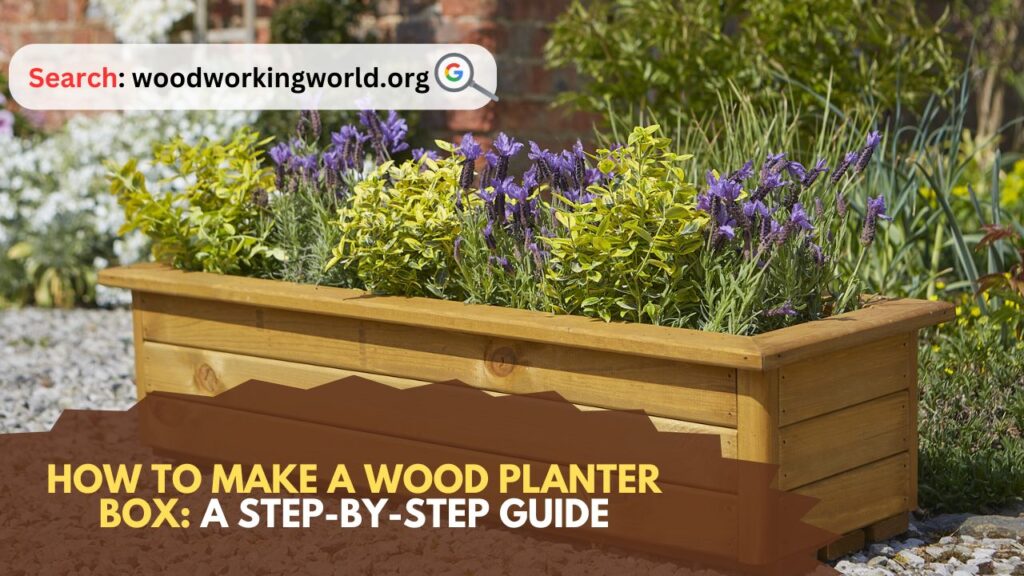Wood Planter Box: Creating your own wood planter box is a rewarding woodworking project that enhances the aesthetics of your garden or patio while providing a practical space for your plants. This comprehensive guide will walk you through the process, from selecting materials to finishing touches. Let’s dive into the steps to make your beautiful wood planter box.

How to Make a Wood Planter Box
Materials and Tools
Materials:
- Wood: Cedar or redwood is ideal due to their natural resistance to rot.
- Galvanized Screws or Nails: To withstand outdoor elements.
- Wood Glue: For added stability.
- Landscaping Fabric: To line the interior and prevent soil erosion.
- Exterior Wood Stain or Paint: To protect the wood from weather damage.
- Soil and Plants: Your choice of soil and plants for filling the planter box.
Tools:
- Tape Measure: For accurate measurements.
- Saw: A circular saw or hand saw.
- Drill: For making pilot holes and driving screws.
- Hammer: If using nails.
- Clamps: To hold pieces together while assembling.
- Sanding Block or Electric Sander: For smoothing the wood.
- Paint Brushes or Rollers: For applying stain or paint.
Step-by-Step Instructions
1. Plan and Measure
Before you start cutting any wood, decide on the dimensions of your planter box. A common size is 2 feet long, 1 foot wide, and 1 foot tall, but you can adjust these dimensions based on your needs. Sketch a simple plan to visualize your design and list the dimensions of each piece you need to cut.
Pro Tip: Make your planter box at least 6-12 inches deep to accommodate most plant roots.
2. Cut the Wood
Using your saw, cut the wood according to your plan. For a basic rectangular planter box, you will need:
- 4 Side Panels: 2 long pieces for the front and back, and 2 shorter pieces for the sides.
- 1 Bottom Panel: Sized to fit inside the assembled frame.
- 4 Legs (optional): If you want your planter box elevated.
Smooth all cut edges with a sanding block or electric sander to avoid splinters and ensure a clean fit.
3. Assemble the Frame
Begin by assembling the four side panels. Apply wood glue to the edges where the panels meet, then clamp them together. Drill pilot holes to prevent the wood from splitting, and drive screws or nails into the holes to secure the panels together.
Pro Tip: Use a carpenter’s square to ensure the corners are at right angles.
4. Attach the Bottom Panel
Once the frame is assembled, fit the bottom panel inside. Apply wood glue along the edges of the bottom panel where it meets the frame, then secure it with screws or nails. Ensure the bottom panel is well-supported to hold the weight of the soil and plants.
5. Add Legs (Optional)
If you are adding legs to your planter box, cut the wood to your desired height and attach them to each corner of the box. Use wood glue and screws to ensure they are firmly secured.
6. Drill Drainage Holes
To prevent water from accumulating and causing root rot, drill several drainage holes in the bottom panel. Space the holes evenly to allow excess water to escape.
7. Sand the Entire Box
Give your planter box a thorough sanding to smooth out any rough edges or surfaces. This step is crucial if you plan to paint or stain the wood, as it will ensure an even finish.
8. Apply Wood Stain or Paint
Choose an exterior wood stain or paint to protect your planter box from weather damage. Apply the stain or paint with a brush or roller, following the manufacturer’s instructions for drying times and additional coats. This step not only enhances the appearance but also extends the lifespan of your planter box.
Pro Tip: Apply at least two coats for maximum protection.
9. Line the Interior
Once the stain or paint is fully dry, line the interior of the planter box with landscaping fabric. This fabric will help prevent soil erosion and improve drainage. Cut the fabric to fit and staple it to the inside of the box, ensuring it covers the bottom and sides completely.
10. Fill with Soil and Plants
Your planter box is now ready to be filled with soil and plants. Choose a high-quality potting mix suitable for the types of plants you are growing. Fill the box with soil, leaving about an inch of space from the top, and plant your chosen flowers, herbs, or vegetables.
Tips for Maintaining Your Wood Planter Box
- Watering: Water your plants regularly, but ensure the soil is not waterlogged to prevent root rot.
- Seasonal Care: Move your planter box indoors or cover it during harsh winter months to protect the wood.
- Re-staining or Painting: Reapply wood stain or paint every couple of years to maintain its protective barrier.
Conclusion: Wood Planter Box
Making your own wood planter box is a satisfying project that combines creativity with practicality. With the right materials, tools, and a bit of patience, you can create a beautiful and durable planter box that enhances your outdoor space. Whether you’re growing flowers, herbs, or vegetables, your handmade planter box will provide a charming and functional addition to your garden. Enjoy the process and the reward of watching your plants thrive in their new home!
I hope this article on Wood Planter Box has been helpful. If you have any further questions, please feel free to leave a comment below.
Video
